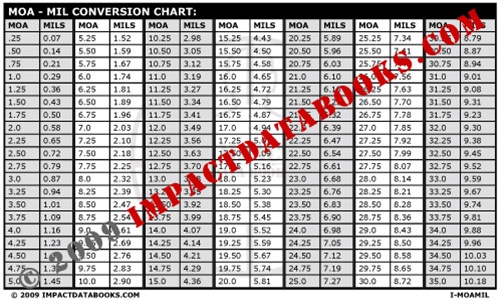Re: Mil-MOA conversion Technical question
<div class="ubbcode-block"><div class="ubbcode-header">Originally Posted By: Ratbert</div><div class="ubbcode-body"><div class="ubbcode-block"><div class="ubbcode-header">Originally Posted By: Sterling Shooter</div><div class="ubbcode-body"><div class="ubbcode-block"><div class="ubbcode-header">Originally Posted By: Ratbert</div><div class="ubbcode-body">Everyone loves to point out how you can do IPHY math in your head. For instance a 6" target / 2 IPHY x 100 = 300 yds. Whee. Now do it for a 17" target that mils out @ 2.35 Mil.
In the real world you aren't gonna be doing it in your head, not if you want to make sure it's right and you want the answer anytime soon. So you're going to be using a calculator or a chart or a MDM. So it's no different than Mils.
If you're only going to be in situations where things work out like example #1, then another method is to just glance up at the sign and see which firing line you're laying on.
For Holds, movers, and windage no math should be involved at all for any system if you've setup your data book correctly.
</div></div>
I'm sure you're an expert at it all, but doing wind calculations in your head is a really good thing to be able to do.
</div></div>
What wind calculations? Are you talking about being able to convert a 10MPH wind value into a 3 MPH wind value? That is the same math if you've recorded in Mils, MOA, IPHY. If you're still talking about converting your wind drift into inches then you're still ignoring the fact that you're the only person discussing iron sights in a thread revolving around a question posed about how to use an optic. And even then it's not such a big deal to multiply your mil reading by 3.5 and then follow the IPHY method to get something as accurate as you can visualize holding off a man-sized target with random background clutter @800+ yds.
I've got a lot of respect for you as a shooter but it pains me that you can't seem to let go of the idea that everyone isn't going to wake up one day and decide to shoot only NRA HP as god and Stoner intended. </div></div>
In my head; distance divided by 100, times velocity in MPH, divided by constant, equals MOA of drift. It's good for any sight/scope type, favor or clicks. No cards, calculators, or charts, etc. Everything done while aiming after inital wind estimation.
<div class="ubbcode-block"><div class="ubbcode-header">Originally Posted By: Ratbert</div><div class="ubbcode-body"><div class="ubbcode-block"><div class="ubbcode-header">Originally Posted By: Sterling Shooter</div><div class="ubbcode-body"><div class="ubbcode-block"><div class="ubbcode-header">Originally Posted By: Ratbert</div><div class="ubbcode-body">Everyone loves to point out how you can do IPHY math in your head. For instance a 6" target / 2 IPHY x 100 = 300 yds. Whee. Now do it for a 17" target that mils out @ 2.35 Mil.
In the real world you aren't gonna be doing it in your head, not if you want to make sure it's right and you want the answer anytime soon. So you're going to be using a calculator or a chart or a MDM. So it's no different than Mils.
If you're only going to be in situations where things work out like example #1, then another method is to just glance up at the sign and see which firing line you're laying on.
For Holds, movers, and windage no math should be involved at all for any system if you've setup your data book correctly.
</div></div>
I'm sure you're an expert at it all, but doing wind calculations in your head is a really good thing to be able to do.
</div></div>
What wind calculations? Are you talking about being able to convert a 10MPH wind value into a 3 MPH wind value? That is the same math if you've recorded in Mils, MOA, IPHY. If you're still talking about converting your wind drift into inches then you're still ignoring the fact that you're the only person discussing iron sights in a thread revolving around a question posed about how to use an optic. And even then it's not such a big deal to multiply your mil reading by 3.5 and then follow the IPHY method to get something as accurate as you can visualize holding off a man-sized target with random background clutter @800+ yds.
I've got a lot of respect for you as a shooter but it pains me that you can't seem to let go of the idea that everyone isn't going to wake up one day and decide to shoot only NRA HP as god and Stoner intended. </div></div>
In my head; distance divided by 100, times velocity in MPH, divided by constant, equals MOA of drift. It's good for any sight/scope type, favor or clicks. No cards, calculators, or charts, etc. Everything done while aiming after inital wind estimation.



